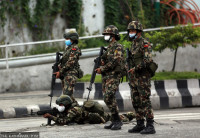National
Transitional Justice Act Amendment: Draft defines disappearance
Ten years after the end of the decade-long armed struggle during which nearly 1,500 citizens were disappeared—and two years after the formation of a commission to look into cases of disappearance—there is finally some clarity on the horizon when it comes to defining the “disappeared persons”.
Dewan Rai
Ten years after the end of the decade-long armed struggle during which nearly 1,500 citizens were disappeared—and two years after the formation of a commission to look into cases of disappearance—there is finally some clarity on the horizon when it comes to defining the “disappeared persons”.
A draft of the first amendment to the Enforced Disappearances Enquiry, Truth and Reconciliation Commission Act 2014 has proposed that only the incidents of “continuous disappearance”—those who never returned—will come under the jurisdiction of the Commission of Investigation on Enforced Disappeared Persons (CIEDP).
The CIEDP and the Truth and Reconciliation Commission (TRC) formed two years ago to look into war-era cases have collected around 60,000 complaints.
The terms of both the commission expire on Friday.
The proposed definition of “the disappeared” is likely to bring the number of incidents of disappearance down almost by half. The CIEDP has received around 3,000 complaints related to enforced disappearance during the insurgency, which claimed more than 13,000 lives.
Of the total complaints registered with the CIEDP, some are from the relatives of those who were detained illegally and held incommunicado for months and those whose death in detention was already ascertained. “The commission has been entrusted with the responsibility of finding out the truth about those persons who were disappeared—and never came back—for political reason,” said CIEDP Chairperson Lokendra Mallick. “If a ‘disappeared’ person returned home after being in illegal detention or someone’s death has already been established, the case will fall under TRC’s jurisdiction.” Illegal detention and hostage taking can be defined either as kidnapping or torture, and the TRC has to deal with these cases. Besides, the commission has also received complaints about “other missing persons” whose disappearance is not related to insurgency.
The CIEDP has been mandated to look into incidents that took place between February 16, 1996 and November 21, 2006. The CIEDP’s mandate allows it to investigate only those cases which are related to the insurgency. Lack of legal clarity has created difficulty in finding the exact number of cases of disappearance.
The Ministry of Peace, which provided compensation to conflict victims, has maintained a record of 1,475 disappeared persons, while the National Human Rights Commission’s record has put the number of incidents of disappearance at 843. An updated report of the International Committee of the Red Cross and the Nepal Red Cross Society, however, has put the number of missing persons at 1,334. “We believe all those people, who had not registered their complaints with any rights organisation, have registered complaints with the CIEDP,” said Mallick. “But we have also received a sizeable number of complaints of disappearance not directly related to insurgency.” Now that the proposed amendment has also criminalised the act of disappearance, the CIEDP wants to start filling out anti-mortem forms immediately after the government extend its term.
The lowdown
- The draft of the first amendment to the Enforced Disappearances Enquiry, Truth and Reconciliation Commission Act 2014 criminalises the act of disappearance
- Proposes that only the incidents of ‘continuous disappearance’ will come under the jurisdiction of the Commission of Investigation on Enforced Disappeared Persons
- If a ‘disappeared’ person returned home after being in illegal detention or someone’s death has already been established, the case will fall under Truth and Reconciliation Commission’s jurisdiction
- The draft proposes 20-year jail term for those found guilty of disappearing someone




 15.12°C Kathmandu
15.12°C Kathmandu













%20(1).jpg&w=300&height=200)

